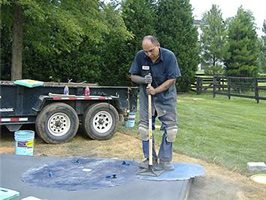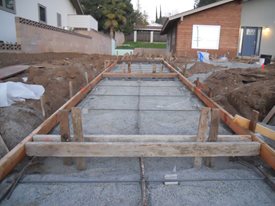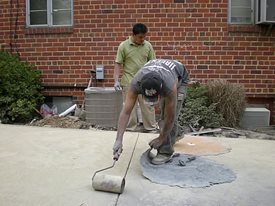
Artesano Decorative Concrete in Gaithersburg, MD
The short answer is NO! Before I go any further I have to confess that I am a weekend warrior, and I love doing projects around the house. There isn’t much I won't try to tackle myself, so making the statement that stamped concrete is NOT a DIY project doesn’t come lightly from my lips.
Find stamped concrete contractors near me.
9 reasons why stamping concrete is better left to the pros:
Proper sub-base preparation
This often includes 2 to 4 inches of sub-base material or stone that needs to be properly spread and compacted.Forming
This requires proper form materials and an understanding of elevations and slope. If the proper slope isn’t maintained on concrete flatwork, you end up with puddling or standing water issues known as "bird baths". As with most everything concrete, these low spots are very difficult to repair, especially if any aesthetic value is desired.Labor
Standard concrete weighs about 150 pounds per cubic foot. Unless you are lucky enough to have a job where a ready-mix concrete truck can pull right up to the formed area, you will be moving concrete via wheel-barrow or paying someone to pump it for you. Also consider that most ready-mix companies charge penalties if the truck sits at a job site for longer than 30 to 60 minutes.Concrete mix
Most do-it-yourselfers aren’t familiar enough with the components of concrete mix, what admixtures to use and proper slump consistency. Modern concrete is a high-tech material that contains more than sand, stone, cement and water. The water-to-cement ratio is the biggest issue with color development as well as surface strength and durability. An incorrect ratio can lead to washed-out color and spalled concrete within the first year. Environmental conditions need to be considered as well, not only on the day of the pour, but also long term.Finishing
Any professional concrete installer will tell you that placing and finishing plain concrete is as much of an art as it is a technique. It takes years to even get a handle on the basics, let alone get good at it. Take it to the next level and add in stamping, and you just increased the learning curve by another 3 to 5 years. Placing concrete, while often overlooked, is critical. Improperly placed concrete can cause failure within the first year.Color
With the growth of integrally-colored concrete and the ability of most ready-mix companies to provide it, ordering and getting colored concrete has become the easiest step involved. However, the factors involved in making sure the color turns out correctly can play havoc with the job. Instead of listing all the potential issues, spend a few minutes in the technical troubleshooting section or look through these common coloring issues to see for yourself.
Options for Coloring Stamped ConcreteStamping
The most unforgiving part is the actual stamping itself. A good stamped concrete job looks good, while a fair-to-poor stamp job looks horrible. Dealing with poor placement or poor finishing is one thing, but if the imprinting process isn’t done properly, it’s extremely difficult and expensive to repair. Each stamp fits together a certain way, and once you start stamping you can't go back and start over if you mess up the pattern or get off line with the texture.Tools
Stamped concrete is also no different than most projects; you have to sweat the details. Having the right detail tools for the pattern and texture are critical to ending up with a good stamp job. The stamps themselves can cost thousands of dollars if you buy them and hundreds if you decide to rent. A homemade concrete stamp can be made using liquid rubber, but this adds another layer of complexity to the project.
Shop for stamps and skins from leading manufacturers.Curing & sealing
After the actual stamping process is completed, the job isn’t done. In fact, the curing, cleaning and sealing processes typically cause more issues than the previous steps outlined above.

Concrete Network

Artesano Decorative Concrete in Gaithersburg, MD
I’m all about the bottom line, and the bottom line is that stamped concrete is not a DIY-friendly project. Don't be fooled that you are prepared and ready to stamp just by watching a 5-minute how-to video, as these provide just enough information to really get you in trouble. My advice is plain and simple: Stamped concrete is better left to the professionals.
Stamping Resources for DIYers
For those DIY'ers still brave enough to want to try stamping concrete themselves after reading my attempts to talk you out of it, here's an overview of the steps involved when stamping concrete: How to Stamp Concrete.
If you'll only be doing one project, renting a set of stamps will save you money. Check local supply stores to see if they offer daily stamp mat rentals.
Find concrete stamp rentals near me:
- Charlotte and Raleigh, NC - Turning Point Supply
- Cinnaminson, NJ - Sealant Depot, Inc.
- Ft. Worth, Buda, and Houston, TX - Decorative Concrete Supply
- Oklahoma City, OK - Moon Decorative Concrete
- Shawnee, KS - Decorative Concrete Supply
- Throop, PA - Concrete Texturing Tool & Supply